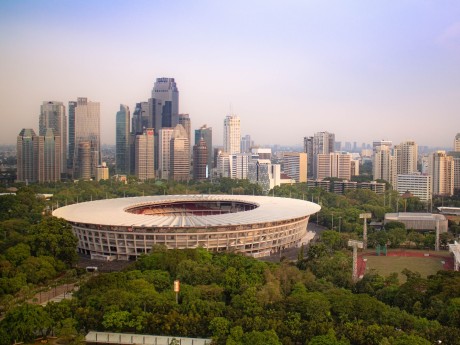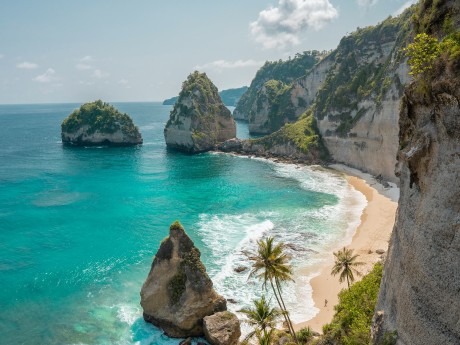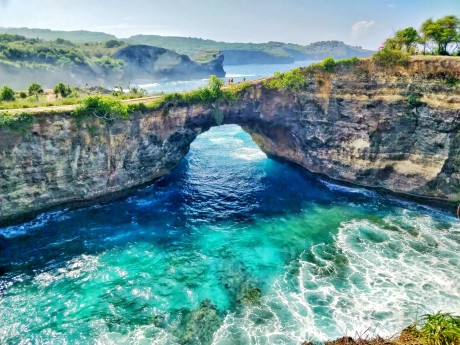Indonesia: Jakarta and Bali
Be amazed at the stunning natural beauty and rich culture of Indonesia. Visit the iconic National Monument in Jakarta or shop at the Pasar Baru market. In Bali, relax on the sandy shores and swim in the crystal clear waters. Don't forget to try some of the delicious Indonesian cuisine, such as nasi goreng or satay. Take a boat ride to see the dolphins in Lovina or go scuba diving in the coral reefs around Amed. Head to the southern beaches for surfing and sunbathing.
Read more
Be amazed at the stunning natural beauty and rich culture of Indonesia. Visit the iconic National Monument in Jakarta or shop at the Pasar Baru market. In Bali, relax on the sandy shores and swim in the crystal clear waters. Don't forget to try some of the delicious Indonesian cuisine, such as nasi goreng or satay. Take a boat ride to see the dolphins in Lovina or go scuba diving in the coral reefs around Amed. Head to the southern beaches for surfing and sunbathing. Adventure seekers can travel inland to the town of Ubud, known for its scenic jungles and rice fields, offering the perfect playground for riding ATVs, white water rafting and mountain biking. A trip inland wouldn’t be complete without visiting the Sacred Monkey Forest Sanctuary, the many coffee plantations and hiking up the active volcanoes, Mt Batur and Mt Agung. For a truly unique experience, don’t forget to visit the famous Uluwatu temple and watch a live Kecak dance performance. Waterviews offers hotels within walking distance to water and optional activities via our “Add Activities’’ button in our booking page. All Prices include taxes and Hotel charges are on a per room basis. To customize this trip to your personal preferences, contact us at: Service@waterviewstravel.com
Destinations
- Jakarta
- Bali
Itinerary
Jakarta

As Indonesia's capital and largest city, Jakarta is a vibrant and fast-paced metropolis that is sure to mesmerise everyone who visits. The city is home to a melting pot of cultures, and offers a diverse culinary scene, vibrant nightlife, green parks and rich history as well as an array of interesting attractions such as monuments and museums. There are also a wide range of amenities here that cater to every type of traveller, making the city well worth the visit for both short stopovers and entire trips.
Read more
As Indonesia's capital and largest city, Jakarta is a vibrant and fast-paced metropolis that is sure to mesmerise everyone who visits. The city is home to a melting pot of cultures, and offers a diverse culinary scene, vibrant nightlife, green parks and rich history as well as an array of interesting attractions such as monuments and museums. There are also a wide range of amenities here that cater to every type of traveller, making the city well worth the visit for both short stopovers and entire trips.
Additional Information
Jakarta's nickname among expats is the Big Durian, and like the fruit itself, it's a shock at first sight (and smell): a sweltering, steaming, heaving mass of some 30 million people packed into a vast urban sprawl. The metropolitan area is a charm and melting pot for Indonesians, both as a business and a government centre, and the most developed city in the country. But all of this comes at a cost: the city has been struggling very hard to keep up with the urban growth. Major roads are packed up during rush hours and weekends (sometimes all day during rainy season due to motorcyclists sheltering under the fly-over or the tunnel when it's raining heavily, thus causing additional congestion), while the public transportation system has been unable to alleviate that much traffic. Housing the population has been a problem too and adding to that, the numerous people's mentality are yet to make the city a great place to live in, as dreamed of.
All that said, while initially a bit overwhelming, if you can withstand the pollution and can afford to indulge in Jakarta's charms, you can discover what is also one of Asia's most exciting, most lively global cities. There is plenty to do in Jakarta, from green parks and historical centres, to cosmopolitan shopping, diverse gourmet choices, and some of the hippest nightlife in Southeast Asia!
To cite a couple of figures that further clarify the position of Jakarta relative to the rest of the world, the city's Human Development Index is categorised as High Human Development with a value of 0.694, whereas the category of Very High Human Development starts at 0.800 and would apply to the USA, Japan and most European countries. Jakarta's Human Development Index number is higher than or on par with Turkey and most Balkan countries.
History
The port of Sunda Kelapa dates to the 12th century, when it served the Sundanese kingdom of Pajajaran near present-day Bogor. The first Europeans to arrive were the Portuguese, who were given permission by the Hindu Kingdom of Pakuan Pajajaran to erect a godown (warehouse) in 1522. Control was still firmly in local hands, and in 1527 the city was conquered by Prince Fatahillah, a Muslim prince from Cirebon, who changed the name to Jayakarta.
By the early 17th century, however, the Dutch had pretty much taken over the port city, and the razing of a competing English fort in 1619 secured their hold on the island. Under the name Batavia, the new Dutch town became the capital of the Dutch East Indies and was known as the Queen of the East.
However, the Dutch made the mistake of attempting to replicate Holland by digging canals throughout the malarial swamps in the area, resulting in shockingly high death rates and earning the town the epithet White Man's Graveyard. In the early 1800s most canals were filled in, the town was shifted 4 km inland and the Pearl of the Orient flourished once again.
In 1740, Chinese slaves rebelled against the Dutch. The rebellion was put down harshly with the massacre of thousands of Chinese slaves. The survivors were exiled to Sri Lanka.
In 1795, the Netherlands were invaded and occupied by France, and on March 17, 1798, the Batavian Republic, a satellite state of France, took over the VOC's debts and assets. But on August 26, 1811, a British expedition led by Lord Minto defeated the French/Dutch troops in Jakarta, leading to a brief liberation and subsequent administration of Indonesia by the British (led by Sir Stamford Raffles of Singapore fame) in 1811-1816. In 1815, after the Congress of Vienna, Indonesia was handed over from the British to the Dutch government.
The name Jakarta was adopted as a short form of Jayakarta when the city was conquered by the Japanese in 1942. After the war, the Indonesian war of independence followed, with the capital briefly shifted to Yogyakarta after the Dutch attacked. The war lasted until 1949, four years after Indonesian Independence, when the Dutch accepted the independence and handed back the town, which became Indonesia's capital again.
Since independence, Jakarta's population has skyrocketed, thanks to migrants coming to the city from across the Indonesian archipelago. The entire Jabodetabek (Jakarta-Bogor-Depok-Tangerang-Bekasi) metropolitan region is estimated to have a population of about 30 million.
Climate
Jakarta, like the rest of Indonesia, is under the tropical climate classification. It has two distinct seasons, rainy and dry. It is hot and usually humid with little fluctuation in temperature throughout the year. The average temperature is about 28°C (82°F), hot compared to other cities across Indonesia, especially because of the absence of trees in many areas.
November to March is the peak of the rainy season, and floods and traffic chaos on many of the streets usually occur. At its worst, floods can result in standstill on the prone spots and takes a few days to subside; recent canal widening and cleanings have mitigated the effect substantially and for most major roads, a couple hours is all it takes for the standing water to be wiped out. Even in rainy seasons, the sun usually appears for hours each day. During the transition from rainy to dry season or vice versa (April-May & September-October), there is occasional rain. Sometimes it pours; other times it's not a washout. The good thing is that it cools down the air after a sweltering hot day. The rain is almost always absent from June through August.
Tourism information
© Sourced from Wikivoyage
Bali

With its diverse offerings, laid-back atmosphere, rich traditions and incredible nature, Bali is truly one of Indonesia’s most mesmerising destinations. From its white sand beaches and world-class waves to its extraordinary temples and mouth-watering traditional cuisine, this island has something to offer for every type of traveller and is a must on any itinerary. Kuta is the perfect destination for surf enthusiasts and partygoers, while nearby Ubud and Seminyak offer an artistic vibe and a dose of tranquility.
Read more
With its diverse offerings, laid-back atmosphere, rich traditions and incredible nature, Bali is truly one of Indonesia’s most mesmerising destinations. From its white sand beaches and world-class waves to its extraordinary temples and mouth-watering traditional cuisine, this island has something to offer for every type of traveller and is a must on any itinerary. Kuta is the perfect destination for surf enthusiasts and partygoers, while nearby Ubud and Seminyak offer an artistic vibe and a dose of tranquility.





